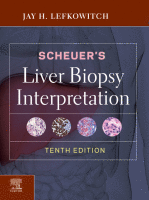Physical Address
304 North Cardinal St.
Dorchester Center, MA 02124

Introduction This chapter deals with the pathology of the important liver lesions attributed to drugs and toxins, with their recognition and with their differential diagnosis. There are hundreds of hepatotoxic drugs and other chemicals, and new reports of adverse drug…

Steatosis Steatosis (fatty change, fatty liver) is the accumulation of abnormal amounts of lipid in hepatocytes. Most steatosis is of the macrovesicular type, in which a single large fat vacuole or several smaller ones occupy the greater part of the…

Introduction Acute hepatitis is not usually an indication for liver biopsy. There are, however, at least three reasons why pathologists sometimes receive liver biopsy samples from patients with acute hepatitis. First, there may be doubt about the clinical diagnosis, or…

Introduction There are many sites along the biliary tree where bile flow may be interrupted, from the bile canaliculi and smallest intrahepatic ducts to the large bile ducts and duodenum ( Fig. 5.1 ). Damage or obstruction at these various…

Initial examination and reporting Naked-eye examination and description of biopsy specimens Although naked-eye examination and description are of limited diagnostic value, they reduce the possibility of specimen identification error. The pathologist should make sure that the whole specimen has been…

Structures and components Functional units and nomenclature Under the low power of the light microscope, normal liver is seen to have a regular structure based on portal tracts and efferent veins. The smallest portal tracts contain portal venules, hepatic arterioles…

Processing of the specimen As soon as a needle biopsy specimen is obtained from the patient, it should be expelled gently into fixative or onto a piece of glass, card or wood. Filter paper is less suitable because fibres tend…

Introduction Liver biopsy is one of many diagnostic tools used in the evaluation and management of patients with liver disease. It continues to play an important role because the concepts and classifications of liver disease are rooted in morphology. Moreover,…